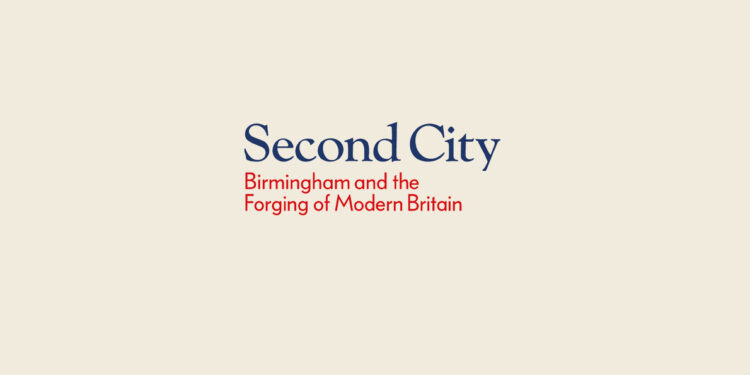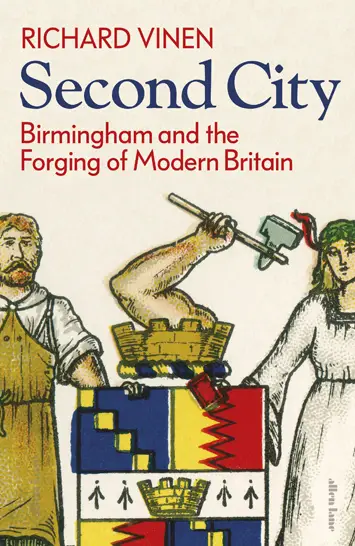Second City by Richard Vinen – Review

By Clare Jenkins
The theatre critic Kenneth Tynan once described his home town of Birmingham as “the ugliest city in Europe… a cemetery without walls”.
Tynan was never, of course, a man to mind his Ps & Qs. He was, after all, the first person to use the word f**k on live television and was preposterously rude about some of Britain’s greatest actors and writers, including Vivien Leigh, Ralph Richardson and Noel Coward – who called him another four-letter word before inviting him to dinner.
Even so, Tynan did have a point about Birmingham. And it’s a point explored fully in Richard Vinen’s comprehensive biography of his home city. Vinen – Professor of History at King’s College, London – is no sentimentalist. “Why does Birmingham exist?” he asks early on. “It is not explained by any natural feature.”
Certainly, it’s flat – as the view from the top of the Rubik’s Cube-style central library reveals. The nearest hills are miles away, there isn’t a significant river running through it (though there is a significant canal), its boundaries are amorphous and it’s about as far from the sea as anywhere in England can be. Maybe that’s why it’s often been overlooked – “an ignored void at the heart of the country”, as the critic Jonathan Meades has written.
It’s also messy, and car-clogged. Many people have blamed that mess and four-wheel worship on Herbert Manzoni, the city surveyor and engineer for over two decades after the Second World War. Arguing for the near-blitzing of the city in the 1950s and 60s, he declared: “There is little of real worth in our architecture. Its replacement should be an improvement…” Thus sowing the seed of horrified recrimination for decades to come – not least for the destruction of the wonderful Victorian central library, where I once worked as a library assistant.
As a former amateur racing motorist, Manzoni also said, “I see no reason why traffic in this country should not reach the proportions of traffic in America…” Be careful what you wish for. In 1971, a Times journalist wrote: “Birmingham is dominated by the motor car. Strangled by a concrete collar of ringways, flyovers and interchanges, it is as if it has been enslaved by its own creation.”
Ironically, while that enslavement continues, the city’s car manufacturing industry is much diminished. As Vinen points out, the annual International Motor Show was held in the NEC from 1978 to 2004, “thereby giving the motoring press a ringside seat from which to watch the death throes of the Birmingham car industry”.
Even before Manzoni set about realising his “vision of Birmingham as the epitome of Americanised modernity”, visitors had failed to see any charm in the place. In Emma, Jane Austen’s social snob Mrs Elton says, “One has no great hopes of Birmingham. I always say there is something direful in that sound.” A hundred years later, J. B. Priestley thought it had “the wrong kind of vulgarity” in its “miles of ugliness [and] squalor”. Even Ozzy Osbourne – not exactly the pinnacle of good taste himself – referred to his home town as “dreary, dismal, polluted”.
I spent my teenage years in Kingstanding, near the largest council estate in Europe and a place prowled by Harry Potter’s Dementors, sucking the souls out of people. On return visits, I can’t help but agree with Vinen’s assessment that Birmingham is “one of the least walkable cities in Britain – not just because it is large but because it is cut up by busy roads that divide its different quarters”. No wonder the complicated interchange of motorways nicknamed Spaghetti Junction is as much an emblem of Birmingham as the Angel of the North is of Gateshead.
Full marks, then, to Vinen for not just, “writing the history of a city that so many of my most distinguished colleagues find uninteresting”, but for making it so interesting.
“Progressive development”
 He traces its history from Anglo-Saxon times through the notable inhabitants of the 16th and 17th Centuries – influential families whose names are echoed throughout the city, like Colmore, Smallbroke, Vesey, Cadbury and Calthorpe. He explores the development of the metalwork industries that were to make Birmingham ‘the workshop of the world’ – snuffboxes, toys, buckles, toothpick cases, kettles, saucepans, trinkets. A third of the UK’s jewellery is still made there. Then the trinkets grew bigger – Birmingham became Motor City, manufacturing 2.3 million vehicles at its peak in 1972, before production started draining overseas.
He traces its history from Anglo-Saxon times through the notable inhabitants of the 16th and 17th Centuries – influential families whose names are echoed throughout the city, like Colmore, Smallbroke, Vesey, Cadbury and Calthorpe. He explores the development of the metalwork industries that were to make Birmingham ‘the workshop of the world’ – snuffboxes, toys, buckles, toothpick cases, kettles, saucepans, trinkets. A third of the UK’s jewellery is still made there. Then the trinkets grew bigger – Birmingham became Motor City, manufacturing 2.3 million vehicles at its peak in 1972, before production started draining overseas.
“High-rise building and road construction were the Siamese twins of Birmingham’s modernity”, as Vinen puts it. So the city became a magnet for people wanting work – not just from the surrounding towns and villages but from the Caribbean, Ireland, the Indian sub-continent.
To accommodate them, the authorities built scores of tower blocks between the 1950s and 70s. A Barbadian bus driver was blunt about the allocation of housing: “Only white people had houses, black people lived in maisonettes or tower blocks”.
Life for Birmingham’s non-white immigrants – many of whom had exchanged a rural life for an intensely urban one – has often been tough. One Jamaican crane driver at the Austin car works, who also worked as a professional boxer, unsurprisingly resented the racism he encountered. “I think hate is just the thing that brought me to boxing. I just wanted to beat somebody’s brains out because I had a pretty rough time here. Hatred brought about by intolerance…”
More hatred and intolerance emerged after the IRA bombing of two city centre pubs in 1974 – this time directed at the large Irish community, drawn there after the war by the promise of jobs in the construction and car industries. What Birmingham MP and Home Secretary Roy Jenkins called “a pervading atmosphere of stricken, hostile resentment” hung over the city in the aftermath. I remember that time, the buses filled with people reading their Evening Mails in shocked, grieving silence. An Irish centre was firebombed, Catholic churches and schools were targeted, Irish people refused service in shops, factory-workers attacked by colleagues in their workplaces.
Yet today’s multicultural Birmingham has been hugely influenced – culturally, educationally, socially, politically – by its immigrants, wherever they originally came from. Vinen addresses all of that, including its cultural and music scene, ranging from Black Sabbath to the roots reggae band Steel Pulse, from the Irish Hurling Boys to the CBSO (whose legendary conductor Sir Simon Rattle tactfully described the city as “not as ugly as Detroit or Cleveland”). And then there were famous residents like poets Louis MacNiece and W. H. Auden, architectural historian Nikolaus Pevsner and anthropologist Tom Harrisson, sociologists Richard Hoggart and Jamaican-born Stuart Hall of the pioneering Centre for Contemporary Cultural Studies.
Religion has always played its part there, too, whether Roman Catholicism or Nonconformism. Some key Dissenters were prominent in the 18th Century Midlands Enlightenment, at whose core were members of the Lunar Society – among them Erasmus Darwin, Matthew Boulton, James Watt, Joseph Priestley and Josiah Wedgwood. All influential men of vision.
Vinen devotes a chapter to the progressive development of the city under another visionary: Joseph Chamberlain, father of Neville and here described as “the most extraordinary British politician of the nineteenth century”. Chamberlain, Liberal mayor of the city for just three years in the 1870s, “pioneered a new degree of municipal activism that made Birmingham seem, as an American journalist put it, ‘the best governed city in the world’.” This, of course, was 100 years ago. Today, the city’s official unemployment rate of nearly ten per cent is comparable to that of Blackpool and pockets of inner London.
Vinen’s sub-title says it all, really – “Birmingham and the Forging of Modern Britain”. While Liverpool led the way with its music scene, Manchester morphed into Manhattan, and Leeds capitalised on its financial acumen, Birmingham was a sort of undercover revolutionary industrial, economic, political and cultural powerhouse. And who knew?
‘Second City: Birmingham and the Forging of Modern Britain’ by Richard Vinen is published by Allen Lane, £25







